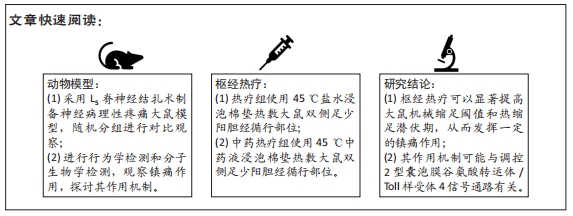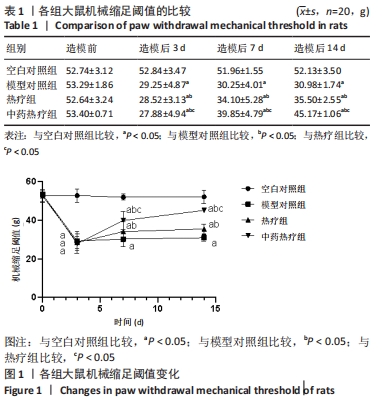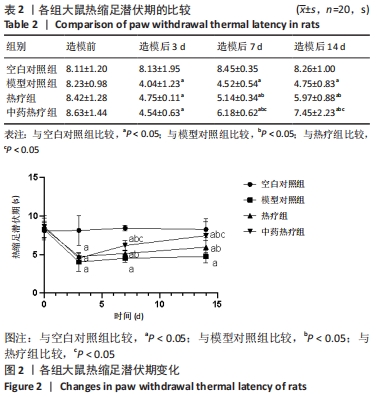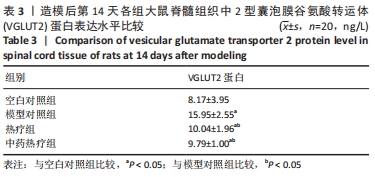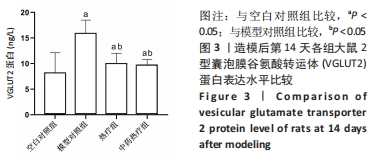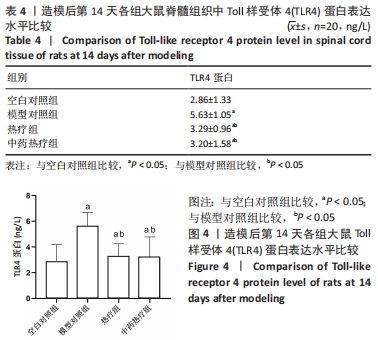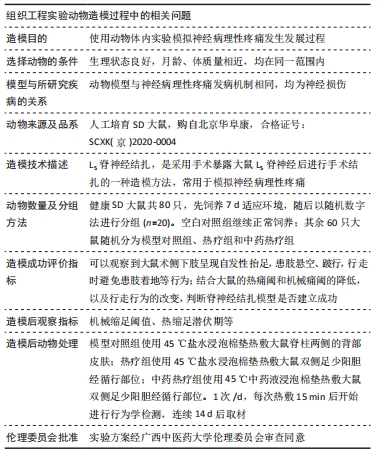[1] SADOSKY A, SCHAEFER C, MANN R, et al. Burden of illness associated with painful diabetic peripheral neuropathy among adults seeking treatment in the us: Results from a retrospective chart review and cross-sectional survey. Diabetes Metab Syndr Obes. 2013;6:79-92.
[2] SCHAEFER C, MANN R, SADOSKY A, et al. Burden of illness associated with peripheral and central neuropathic pain among adults seeking treatment in the united states: A patient-centered evaluation. Pain Med. 2014;15(12):2105-2119.
[3] ZHAO L, CHEN J, LI Y, et al. The long-term effect of acupuncture for migraine prophylaxis-A randomized clinical trial. JAMA Intern Med. 2017;177(4):508-515.
[4] SHINY ES, SAFREENA I. Assess the effectiveness of foot and hand massage on caesarean pain among post-natal mothers. J Obstetr Gynaecol Nursing. 2021; 9(2):26-32.
[5] 庞军,杨鹏,卢栋明,等. 枢经推拿治疗腰椎间盘突出症的临床疗效及对患者病变区域红外热成像的影响[J].广西医学,2021,43(16): 1909-1912.
[6] CHO YS, KO HG, HAN HM, et al. Vesicular glutamate transporter-immunopositive axons that coexpress neuropeptides in the rat and human dental pulp. Int Endod J. 2021;54(3):377-387.
[7] ZENG X, NIU Y, QIN G, et al. Deficiency in the function of inhibitory interneurons contributes to glutamate-associated central sensitization through GABABR2-SynCAM1 signaling in chronic migraine rats. FASEB J. 2020;34(11): 14780-14798.
[8] GAO YH, WANG JY, HAN YJ, et al. Spinal cord Toll like receptor 4 and its co-stimulatory molecule heat shock protein 90 may parti-cipate in electroacupuncture analgesia in rats with chronic neuropathic pain. Zhen Ci Yan Jiu. 2021;46(9):735-741.
[9] DAI GG, WANG Y, LIAO SC, et al. Characteristics and Significance of Gene Expression Changes in Peripheral Blood of Lumbar Disc Extrusion Patients before and after Nonoperative Treatment. Sichuan Da Xue Xue Bao Yi Xue Ban. 2021;52(5):868-876.
[10] KIM SH, CHUNG JM. An experimental model for peripheral neuropathy produced by segmental spinal nerve ligation in the rat. Pain. 1992; 50(3):355-363.
[11] 庞军.枢经学说的理论和应用研究[D].武汉:湖北中医药大学,2010.
[12] 吴金玉,黄仁发,史伟,黄雪霞,覃祚莲.田七注射液对2-4期慢性肾脏病患者微炎症状态及免疫功能的影响[J].广西医学,2012,34(3): 260-263.
[13] 罗翠萍,孙钰,耿猛.分经辨治针刺结合中药热敷治疗神经根型颈椎病的疗效观察[J].中华针灸电子杂志,2019,8(3):92-95.
[14] 宋学军.疼痛信号外周神经转导的分子生物学机制[J].中国疼痛医学杂志,2016,22(1):2-7.
[15] OH JY, HWANG TY, JANG JH, et al. Muscovite nanoparticles mitigate neuropathic pain by modulating the inflammatory response and neuroglial activation in the spinal cord. Neural Regen Res. 2020;15(11): 2162-2168.
[16] LEO S, MOECHARS D, CALLAERTS-VEGH Z, et al. Impairment of VGLUT2 but not VGLUT1 signaling reduces neuropathy-induced hypersensitivity. Eur J Pain. 2009; 13(10):1008-1017.
[17] DRAXLER P, HONSEK SD, FORSTHUBER L, et al. VGluT3(+) primary afferents play distinct roles in mechanical and cold hypersensitivity depending on pain etiology. J Neurosci. 2014; 34(36):12015-12028.
[18] SEAL RP, WANG X, GUAN Y, et al. Injury-induced mechanical hypersensitivity requires C-low threshold mechanoreceptors. Nature. 2009;462(7273):651-655.
[19] LIU Y, ABDEL SO, ZHANG L. VGLUT2-dependent glutamate release from nociceptors is required to sense pain and suppress itch. Neuron. 2010; 68(3):543-556.
[20] BRUMOVSKY P, WATANABE M, HOKFELT T. Expression of the vesicular glutamate transporters-1 and -2 in adult mouse dorsal root ganglia and spinal cord and their regulation by nerveinjury. Neuroscience. 2007; 147(2):469-490.
[21] MOECHARS D, WESTON MC, LEO S, et al. Vesicular glutamate transporter VGLUT2 expression levels control quantal size and neuropathic pain. J Neurosci. 2006;26(46):12055-12066.
[22] SANTOS MS, LI H, VOGLMAIER SM. Synaptic vesicle protein trafficking at the glutamate synapse. Neuroscience. 2009; 158(1):189-203.
[23] ZHANG FX, GE SN, DONG YL, et al. Vesicular glutamate transporter isoforms: The essential players in the somatosensory systems. Prog Neurobiol. 2018;171:72-89.
[24] GU P, PAN Z, WANG XM, et al. Histone deacetylase 5(HDAC5) regulates neuropathic pain through SRY-related HMG-box 10(SOX10)-dependent mechanism in mice. Pain. 2018;159(3):526-539.
[25] MALET M, BRUMOVSKY PR. VGLUTs and glutamate synthesis-focus on DRG neurons and pain. Biomolecules. 2015;5(4):3416-3437.
[26] WANG ZT, YU G, WANG HS, et al. Changes in VGLUT2 expression and function in pain-related supraspinal regions correlate with the pathogenesis of neuropathic pain in a mouse spared nerve injury model. Brain Res. 2015;1624:515-524.
[27] SCHERRER G, LOW SA, WANG X, et al. VGLUT2 expression in primary afferent neurons is essential for normal acute pain and injury-induced heat hypersensitivity. Proc Natl Acad Sci USA. 2010;107(51):22296-222301.
[28] LI Q. Antagonists of toll like receptor 4 maybe a new strategy to counteract opioid-induced hyperalgesia and opioid tolerance. Med Hypotheses. 2012;79(6):754-756.
[29] PLOCIENNIKOWSKA A, HROMADA-JUDYCKA A, BORZECKA K. Co-operation of TLR4 and raft proteins in LPS-induced pro-inflammatory signaling. Cell Mol Life Sci. 2015;72(3):557-581.
[30] ZALI H, GOLCHIN A, FARAHANI M. FDA Approved Drugs Repurposing of Toll-Like Receptor4 (TLR4) Candidate for Neuropathy. Iran J Pharm Res. Summer. 2019;18(3):1639-1647.
[31] 张姗姗,刘漫,刘冬妮,等.TLR4-IN-C34通过抑制TLR4/MyD88/NF-κB/NLRP3信号通路减轻脂多糖诱导的BV2小胶质细胞炎症反应[J].中国药理学与毒理学杂志,2021,35(10):804.
[32] WANG LT, WANG SJ, HSU SH. Functional characterization of mammalian Wntless homolog in mammalian system. Kaohsiung J Med Sci. 2012; 28(7):355-361.
[33] WANG X, LORAM LC, RAMOS K, et al. Morphine activates neuroinflammation in a manner parallel to endotoxin. Proc Natl Acad Sci U S A . 2012;109(16):6325-6330.
[34] FRANCHI S, MORETTI S, CASTELLI M, et al. Mu opioid receptor activation modulates Toll like receptor 4 in murine macrophages. Brain Behav Immun. 2012;26(3):480-488.
[35] LEE JW, NAM H, KIM LE, et al. TLR4 (toll-like receptor 4) activation suppresses autophagy through inhibition of FOXO3 and impairs phagocytic capacity of microglia. Autophagy. 2019;15(5):753-770.
[36] VICHAYA EG, FORD BG, QUAVE CB, et al. Toll-like receptor 4 mediates the development of fatigue in the murine Lewis Lung Carcinoma model independently of activation of macrophages and microglia. Psychoneuroendocrinology. 2020;122:104874.
[37] JIN R, LIU L, ZHU W, et al. Iron oxide nanoparticles promote macrophage autophagy and inflammatory response through activation of toll-like Receptor-4 signaling. Biomaterials. 2019;203:23-30.
[38] LIU Z, MA Y, CUI Q, et al . Toll-like receptor 4 plays a key role in advanced glycation end products-induced M1 macrophage polarization. Biochem Biophys Res Commun. 2020;531(4):602-608.
|
